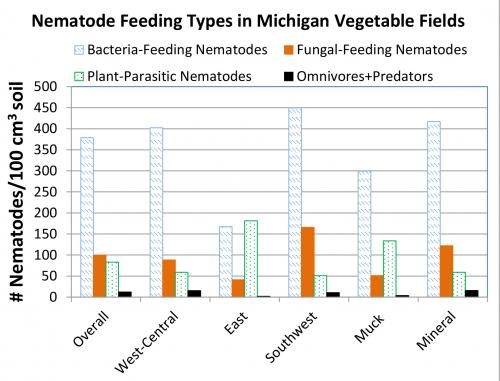Plant-parasitic and beneficial nematode distribution in Michigan vegetable soils
Harmful and beneficial nematodes are present in Michigan soils.

Background
Plant-parasitic nematodes can be serious pathogens of Michigan vegetable crops, particularly root crops such as carrots. Symptoms of nematode infection vary by crop and plant-parasitic nematode type, but include forked, stunted roots and stunted, chlorotic shoots. Only a portion of soil nematodes infect and damage plants (plant-parasitic nematodes). The other types of nematodes (free-living or beneficial nematodes) feed on other organisms such as bacteria, fungi or other nematodes. These beneficial nematodes fill important functions in the soil including nutrient cycling, plant residue decomposition and pathogen suppression.
Procedures
During the growing season or shortly after harvest in 2015, soil nematode populations were assessed in 32 Michigan vegetable fields with prior crop quality issues. Muck and mineral soils in the major carrot producing regions of Michigan were sampled including the west-central region (Mason, Oceana, Newaygo and Kent counties), the southwest region (Berrien County) and the east region (Lapeer County).
Plant-parasitic nematode distribution
Plant-parasitic nematodes were detected in all fields except for two fields in the southwest. Overall, lesion nematode was the most prevalent type of plant-parasitic nematode (72 percent of fields sampled) followed by root-knot nematode (44 percent), pin nematode (28 percent) stunt nematode (28 percent) and cyst nematode (19 percent). Spiral nematodes were also detected in two fields and stubby-root, lance and dagger nematodes were detected in one field each. Based on these results, plant-parasitic nematode infestation is common in Michigan vegetable fields and economic loss due to nematodes may be widespread in Michigan.
In the west-central region, lesion nematode was the most prevalent plant-parasitic nematode (87 percent of fields sampled) followed by root-knot nematode (detected in 47 percent of fields sampled in soil or bioassay), stunt nematode (27 percent), pin nematode (20 percent) and spiral nematode (14 percent). Cyst and dagger nematodes were detected in one field each.
In the southwest region, lesion nematode was most prevalent (67 percent of fields sampled) followed by stunt (56 percent) and root-knot nematodes (33 percent). Stubby-root and lance nematodes were each detected in one field.
In the east region, pin (100 percent of fields sampled), cyst (83 percent), root-knot (50 percent) and lesion nematodes (33 percent) were detected. Population densities of plant-parasitic nematodes in each region, field and soil type can be found in the Michigan State University Extension fact sheet, “Plant-Parasitic and Beneficial Nematode Distribution in Michigan Vegetable Soils.”

Nematode feeding types in Michigan Vegetable fields.
Beneficial nematode population densities
Beneficial nematodes were present in every field and outnumbered plant-parasitic nematodes, on average, in all regions and soil types (see figure). Averaged across regions and soil types, bacteria-feeding nematodes had the highest density with 67 percent relative abundance (percent of total nematode abundance) followed by fungal-feeding nematodes (16 percent relative abundance), plant-parasitic nematodes (14 percent relative abundance) and omnivore-predators (3 percent relative abundance). The proportion of plant-parasitic nematodes was greater in the east region (46 percent of total nematode abundance) and muck soils (27 percent).
Bacteria-feeding nematodes help cycling nutrients into plant-available forms and increase rapidly in the presence of abundant, simple resources such as sugars. Fungal-feeding nematodes increase relatively rapidly with abundant resources, and are involved in breakdown of recalcitrant materials such as fibrous plant material. Omnivores and predators can feed on other nematodes and can help limit plant-parasitic nematode densities. Omnivores and predators do better in a more stable (fewer changes) soil environment.
The high proportion of bacteria-feeding nematodes relative to other types of nematodes suggests Michigan vegetable soil ecosystems are nutrient-rich, but disrupted often and relatively basic. This status is typical of agricultural systems with annual crops.
Acknowledgement: This project was funded in part by the Michigan Carrot Commission, Michigan Vegetable Council, Project GREEEN and the MSU AgBioResearch Hatch project.



 Print
Print Email
Email



